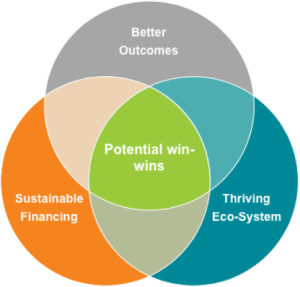Aiming for a #HealthyEU. The quest for aligned interests on policy – how to make an integrated life sciences strategy work
21.05.14
It sounds like a cliché to talk about ‘win-wins’. The notion often comes up in policy discussions, but let’s face it; genuine examples of aligned interests and win-wins are hard to come up. Talk to any senior health policymaker and they will often say they struggle to make the case for health when talking to finance ministries. “Finance Ministries only ever view health as a cost, not an investment”, as one very senior public health official put it to me last week. Talk to industrial policymakers and they will often say that industry competitiveness doesn’t cut any ice when public sector savings need to be found.
In what is the last in our series of pre-election #HealthyEU blogs, I want to go back to basics and reiterate the approach we have taken in our Health and Growth project. From the start, we wanted to do more than simply call for better industrial policy for pharmaceuticals. We have wanted to redefine what industrial policy means for our sector and we’ve wanted to do it in a way that would be welcomed by policymakers who not only focus on competitiveness but also on health and finance.
So, are there any win-wins to be found? The only way to find out is to start by looking at what each perspective is trying to achieve, then to see if any obvious alignment can be reached?
Starting with the toughest – the moneymen (and women). Do finance ministries really only see health as a cost, not an investment? In my experience, no! When I talk to colleagues at DG ECFIN at the Commission or in national treasuries, generally the message I receive is pretty balanced. Yes, of course, their primary focus is on making sure that public expenditure on healthcare is under control. But I rarely get the sense these people don’t care about healthcare. They just want to see if delivered in an efficient and affordable way – and who would argue with that? Now, there are plenty of examples of financially-driven decisions that prove to be short sighted (usually in a period of political panic – see much of the Euro-zone crisis) and I’ve written previously about the need to take the long view. But let’s be under no illusion, financial scrutiny in healthcare is both necessary and here to stay.
In Europe the right of access to healthcare is written into our treaties. It is part of what defines the European Union. As you will often hear Commissioner Borg say, yes health is good for the economy, but it is also a value in itself. So DG SANCO and especially the Health Ministries around Europe are all committed to delivering better quality and more equitable health outcomes for Europe’s citizens.
Finally industrial policy. I’ve written previously about the shift from ‘picking winners’ to ‘horizontal measures’ (and then back again). Suffice it to say, policymakers who focus on competitiveness issues are usually desperate to do the right thing for business, but just need good ideas that are acceptable within the rules of what is appropriate for the public sector to do.
So where does all this leave us? Is there any possible alignment between the desire to improve healthcare whilst fostering a competitive industry and keeping within financial limits? We think there is. We believe it is possible to identify common policy challenges that, if appropriately addressed, would tick all of these boxes. Identifying such common policy goals can and should be at the heart of a new type of industrial policy that isn’t simply about correcting market failures, but is more about an active collaborative effort between public and private sectors in major areas of mutual interest.
The obvious place to start is the challenge of chronic disease. Europe spends around €700bn on chronic disease at the moment and this will only rise further with demographic change. We all urgently need to find better ways of both preventing chronic disease and ensuring the management of it is as efficient as possible. The pharmaceutical industry does not have all the answers to this but we can help through a new generation of public private partnerships. A start would be to invest in common standards for patient data capture that could fuel more value-based decision making, as well as research into new medicines.
If we are successful in jointly making progress in such a major area of policy challenge, I am confident that finance ministries will start to see greater value in such an approach to new industrial policy. An integrated life sciences strategy for Europe, should pick one of the these challenges to start with, should properly evaluate our effectiveness and then use the lessons as a model for future policy.

